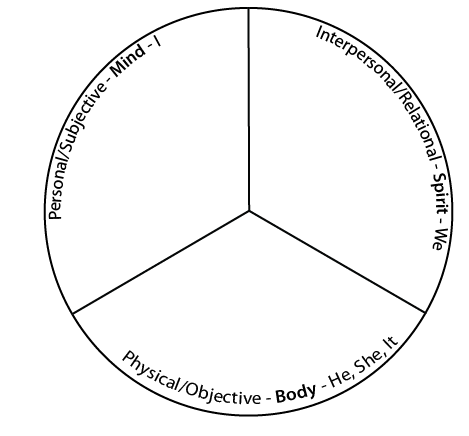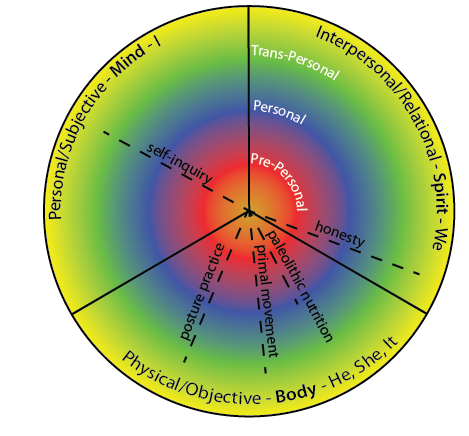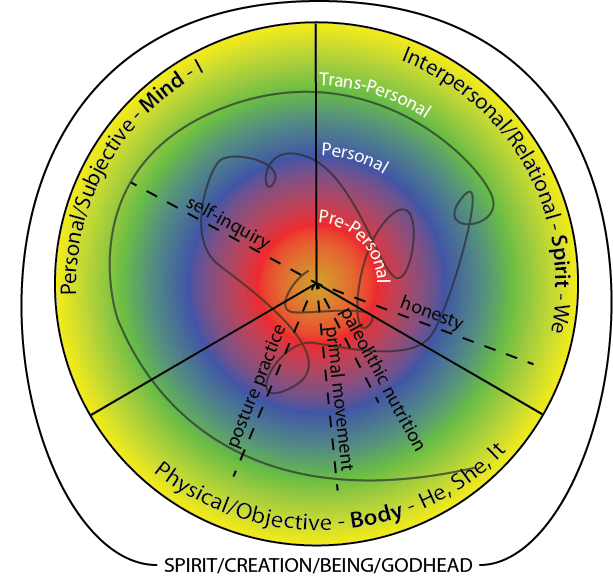The Integral Flow Chart
Two important characteristics of maps should be noticed. A map is not the territory it represents, but, if correct, it has a similar structure to the territory, which accounts for its usefulness.
— ALFRED KORZYBSKI
Well, you’ve made it to the last installment of our introductory “Knowing the Machine” series. In this article, we are going to present what we call the Integral Flow Chart. This could be thought of as a multidimensional map of individual human development. It should be noted that this map is simply our adaptation of Ken Wilber’s AQAL model, and a simple one at that. As nondualists, we have tried to keep the map as simple as possible so as not to run the risk of getting lost in the details. That said, there is a smorgasbord of more complicated — some might also say more comprehensive — versions of this chart you can get lost in if you like. Just Google “Wilber’s AQAL Model” and have at it! For our purposes, we are going to follow the KISS principle — Keep It Simple, Stupid.
Anything you can say about a particular event, behavior, thought, feeling, object, etc can be validated three basic ways. It can be evaluated from a purely subjective, internal-individual perspective. It can be assessed from an inter-subjective, internal-collective perspective. And it can be evaluated from an external, objective perspective. Each perspective has its own particular flavor, if you will. The personal “I” perspective is interested in beauty, and can only be validated through the internal mind’s eye — the eye of the beholder. The relational “we” perspective is concerned with authenticity, truthfulness, and mutual agreement. It wants to know if something makes sense in context, or rings true in relation to personal experience. The objective, physical “it” perspective is interested in verifiable, measurable truth — Just the facts, ma’am.
These three basic flavors can be conceived as three essential dimensions, or matrices, within which everything functions. If we were to use them to draw a basic multi-dimensional map of the human individual, we might end up with the following picture. This is the basis of the Integral Flow Chart. Everything you do/say/think/feel fits primarily into one of these dimensions of human functionality.
To make this chart more useful in mapping personal development, we can now add lines and levels to the picture. Lines are essentially skills we want to develop. Levels are the incremental waves through which we advance along a given line. On the chart below, we present our basic lines in their corresponding dimension, and we bring in three basic levels: pre-personal, personal, and trans-personal. At the pre-personal level, you are a complete newbie along a given line. At the personal level, you have learned the rules and roles and are working within those structures. At the trans-personal level, you have mastered the skill and now know when and how to break the rules with style.
Now we can complete the chart by adding what we call a flow line. The concept of flow was describe brilliantly by Mihaly Csikszentmihalyi in his book, Flow: The Psychology of Optimal Experience, as “a deep sense of enjoyment that is long cherished and that becomes a landmark in memory for what life should be like.” (p. 3) It is “as close to what is usually meant as happiness as anything else we can imagine.” (p. 4). Flow is the feeling of time flying when you’re having fun. It’s what happens when you’re engaged and awake in life.
We also added SPIRIT/BEING/GODHEAD to the structure below. In actuality, you could think of the computer screen itself as the Unified Ground of Being that underlies all apparent things.
Looking at the flow chart above, we see that the flow line tracks a spirallic circle. This is simply because you can never avoid acting within each of the three aspects — mind, body, and spirit — that is to say that you are always moving from experience within a physical context to experience within a personal context to experience within an interpersonal/relational context. You may spend more time in one or another, but you must eventually address them all.
We also notice that the flow line moves progressively outward. If development is balanced — that is if it moves evenly outward within each aspect over time — it is actually moving toward a perfect circle that encompasses the entire chart. This perfect circle represents the transmutation of the mortal human body into the adamantine body — the most complete expression of Godhead in human form.
One last point is that you will notice how the line spirals around its own trajectory at times. This happens because development is not linear. These spirals represent something that has been called the Zone of Proximal Development (ZPD). Basically, the upper end of the zone (closer to the outside of the circle) is how you will perform under the best of circumstances, and the lower end (closer to the inside of the circle) is how you will perform under great stress. Your actual performance at any given time is likely to be somewhere in the middle. Our goal in personal development is to push these spirals out along each line in each matrix, moving toward effortlessly uninhibited flow — the perfect circle.
Of course, this device is not entirely precise. Like we said in the beginning, we are aiming at something conceptual, elegant, and uncluttered. You can add as many lines and levels to the chart as you want. You can try to imagine where you fall as a total individual at different times. You can even use it to identify areas of weakness, but in the end, this particular iteration is really more of a conceptual tool than a practical one.
As a final note, we will acknowledge for those of you already familiar with Integral Theory, that our designation of the relational aspect as “spiritual” and the personal aspect as “mental” is not in line with many popular integral models. We assure you this switch is on purpose and made based on much consideration. For a more detailed reasoning as to why we did this, please read the article on Freeing Your Spirit (second paragraph in particular).
This article is the last in our introductory “Knowing the Machine” series. From here we suggest you take a look at our front pages for each aspect — physical, personal, and relational — to get a more detailed look at the lines on which we will focus within each. Beyond that, please subscribe to the blog and search through the archives for more practical applications.
Get Updates Via E-Mail
What We Do
Start Here
Posts by Dimension
Posts by Subject
Posts by Practicality
Recent Posts
- Interview with Paul Smith, Author of Integral Christianity: The Spirit’s Call to Evolve
- Integrating Asana, Vinyasa, and Prasara in Yoga Posture Practice
- The Highly Played Game of As If – Episode One: The Miracle at the Pool of Bethesda
- Introducing “The Highly Played Game of As If”
- From Asana to Vinyasa to Prasara: The Evolution of a Modern Yoga Practice






